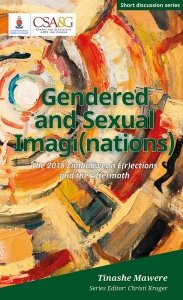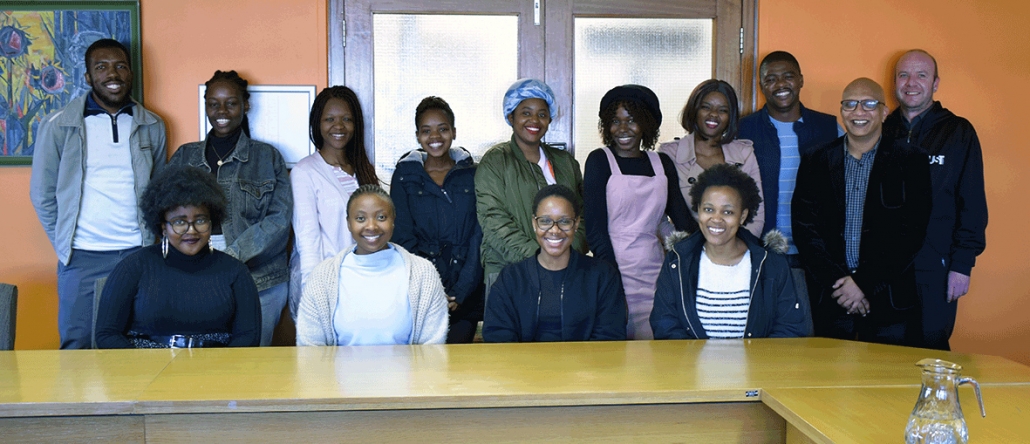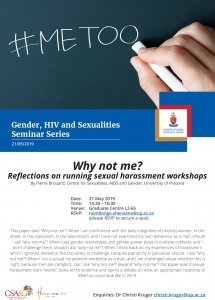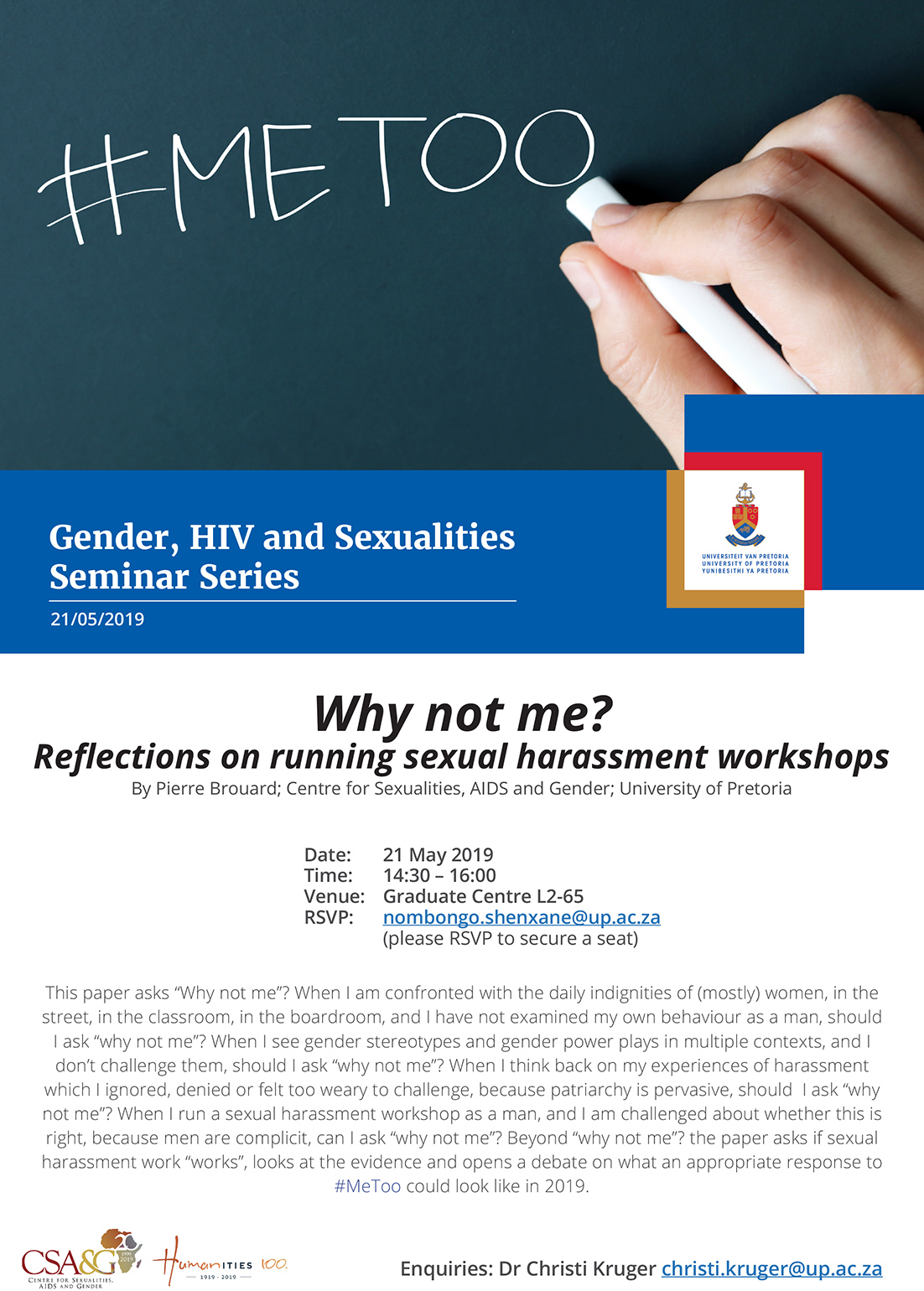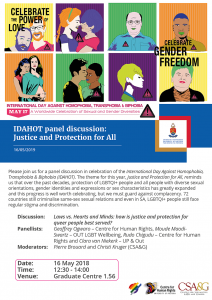The Covid-19 pandemic: Re/making common knowledges and common spaces
Text by Tinashe Mawere
Banter(ing) the Lockdown and gender scripts
Gender scripts and gendered identities are always evident in the everyday. Butler (1988) argues that gendered meanings are made practical and visible through performances of the everyday. Rather than re/locating gender discourses as abstract and located in a world farfetched, it is important that we get realistic and focus on our everyday lives by reflecting on the current Coronavirus, Covid-19-induced lockdown. A quick and random survey of WhatsApp media related to the call to stay at home, circulating in groups that have Zimbabweans living in South Africa, reveals some performances of gender and ways in which toxic knowledges and practices about gender are re/produced and transported. The unrolling lockdown period to stop the spreading of Covid-19 in South Africa and Zimbabwe illustrates how a number of banters or jokes have imagined masculinities as struggling within the domestic space. Simultaneously, the female figure, whose position in domestic spaces has been normalised, has been depicted as having no issues with staying at home. This polarisation buttresses dominant and naturalised knowledge that positions particular spaces or locations as suitable for men and others as suitable for women, making gender and social hierarchies sensible.
Homes, masculinities and femininities
In addition to a clear depiction of the family and homes in heterosexual normativity as prescribed by global dominant knowledges (Peterson 2000), the current Coronavirus, Covid-19 lockdown banters also invite us to unpack the notion of home and the complexities of space and gendered identities. The historical and cultural privileging and naturalization of male power is implicated and acted out through notions of family and the distinctions between domestic/private and public/political spaces (Mawere 2019, 2016; Nyambi 2012; Lewis 2002; McClintock 1993). In narrating the situation at home during the lockdown, most banters position the family in the traditional and dominant sense of heterosexuality, with the wife and husband belonging to clearly-opposite sexual categories. This presentation silences non-heterosexual sexualities and supposes a hierarchy of sexualities where heteronormative sexualities are normalized while non-heteronormative sexualities are unspeakable. In the current national lockdown, it is important to problematize the effects of positioning only heteronormative families where multiple sexualities and sexual relations exist and are acknowledged especially in a ‘democracy’ like South Africa. In many ways, therefore, the lockdown is a microcosm of what happens daily in gendered South Africa. In addition to that, this particular familial notion brings in the complex issue of space and location, where space is polarized as domestic/private and public, and associated with distinct sexualities. This continues the existing discourse of specific roles for each named gender (Mawere 2016; Eisenstein 2000; Peterson 2000; McClintock 1993).
While women are portrayed as nurtured to, natural to and fitting neatly within the ‘imprisonment’ of the home, banters related to the national lockdown portray men as misfits in the domestic space and therefore excuse them from what are regarded as marginal spaces, occupations and identities. Men are shown struggling to survive inside the home – in confinement, implying and naturalizing the public and unbound as the space for men. This links to images of men as active, assertive, wild, agentive and dominant in public spaces. Where men are shown to be adapting to some of the characteristics of the domestic space (like child care, kitchen chores and having limited freedom), they are positioned as caricatures of an inverse and unnatural order of the world.
Confining men to the domestic space is tantamount to reducing them to mere boys; and emasculating them since real men cannot be boxed. This is why some of the circulating jokes during the lockdown show men playing with toys and also playing children’s games. While this locates care in femininity, it also locates care and femininity as marginal, since men are involved only because they have nothing else to do after their removal from their ‘serious’ occupations and spaces. In addition, the home is shown as marginal through its association with care and femininity, hence naturalizing and normalizing male power and locating it outside of domesticity.
Media, real or dramatized, that show men defying the lockdown should be understood in the context of men seeking to escape the emasculating aspects of space; and attempts to gain and prove their manhood. At the same time, the press-ups, frog-jumps, ground-rolling and skop ‘n donner, skiet and donner meted on the men who escape by the military is to censor such masculinities that are now challenging the state, the presidency and putting the nation in danger. President Ramaphosa said, “Staying at home, avoiding public places and cancelling all social activities is the preferred best defence against the virus.” This reveals how epidemics like Covid-19 triggered the surveillance of citizens and how self-surveillance and self-discipling of bodies have become markers of good and responsible citizenship.
No images of struggling women have dominated social media, reinforcing the normalcy and naturalness of their location in the domestic space, hence confirming women’s gendered role of nurturing and care. Thus, limiting women to domestic spaces becomes sensible, hence the circulating media related to the lockdown is re/producing the sensible. In many ways, this “normalises the inferior status of women, and asserts the superiority of men and the necessity for control” (Mawere 2019:34).
Historically, women have been denied space in public arenas, with their activity limited to the traditional private and domestic spheres. The collusion of African traditional leaders with the colonial administration during colonialism to curb the movement of African women in urban spaces (Barnes 1992) is important evidence to support this. In Zimbabwe, this is evidenced by the 1980s random raids of women stigmatised as prostitutes and vagrants in what the government called ‘Operation Clean-up’ (Ranchod-Nilsson 2006).
In Zimbabwe, South Africa and elsewhere, women who have attempted to go beyond their domestic spaces or acceptable limitations have been monitored by patriarchal spectacles, and framed as unreasonable. Moreover, efforts have been made to normalize them or to humiliate and crush them. Women in the entertainment industries, like Bev Sibanda and Chiwoniso Maraire (Zimbabwe), and those in politics like Joice Mujuru, Grace Mugabe and Thokozani Khupe (Zimbabwe), Winnie Mandela, Nkosazana Zuma (South Africa) and Joyce Banda (Malawi), in various ways, attempted to break the boundaries of domesticity which made them conflict with the patriarchal order (Mawere 2019, 2016).
The perceived absurdity of women’s occupation of the public space is a global phenomenon, as shown by the 1997 presentation of British women parliamentarians as Prime Minister Tony Blair’s ‘babes’ rather than as serious and independent deployees and the aggressive sexualisation of Sarah Palin, in the 2008 US Presidential elections (O’Neill et al. 2016, Perks & Johnson 2014, Harmer & Wring 2013) and the demonisation of Hillary Clinton in 2016 US elections (Ritchie 2013). During Zimbabwe’s national elections in 2018, after criticising wives of Zanu-PF politicians for breaking their boundaries and sneaking into public spaces through politics, Nelson Chamisa, the MDC presidential candidate, asserted his power, authority and competency for national presidency. He bragged about “his ability to keep his wife in the right space, i.e. in the domestic sphere. For him, failure to understand properly roles and responsibilities and to act accordingly accounted for Zimbabwe’s failure to grow and flourish” (Mawere 2019:63-64).
In many ways, the home is marginalised and this consequently naturalises social hierarchies based on women’s subordination (Mawere 2016; Yuval-Davies, 1997). Through the silencing of women’s experiences during the lockdown, the home is regarded as commonplace for femininities. Where women characters are shown, they are rather portrayed in a jovial mood since they are made extensions of the environment or as satirising the ‘locked down’ or captured men or rather making men’s lives unbearable by giving them ‘domestic’ chores like cleaning and laughing at them for being locked down. This speaks to what Gaidzanwa (1985) describes as the depiction of women as witches, which is characteristic of many literary texts. These negative images position women as vindictive and evil, substantiating the evil-woman motif which has largely been used as the basis for women elimination and exclusion from particular spheres of life that are deemed essential.
This is also supported by the Madonna-Whore complex where women either saint or sinner, but not both. Literature has shown that women are eliminated and excluded because of the negative images used to characterise them (Mawere 2019; Gaidzanwa 1985). Naturalising and normalising home as a space for women is a way of trivialising women and deterring them from participating in the public or in what are naturalised and normalised as male spaces (O’Neill, Savigny and Cann 2016). This accounts for the lack of cultural, structural and ideological support for women to occupy public spaces and provides reason for the policing of women’s bodies by patriarchy.
The home is associated with the private and is never thought of as the place for men. Addressing the nation, Ramaphosa directed, “From midnight on Thursday 26 March until midnight on Thursday 16 April, all South Africans will have to stay at home.” Staying at home metaphorically implies the emasculation of men. Most men who defied the lockdown did so to subvert their feminisation by the disease, by the threat of a foreigner, an intruder (especially in the context where the Coronavirus, Covid-19 has been associated with foreignness and whiteness, as articulated by Zimbabwe’s defence minister, Oppah Muchinguri-Kashiri who publicly said that coronavirus is God’s punishment for Western countries[1]). Breaking the imposed boundaries and going into the public and expansive spaces is therefore a reassertion of masculinities.
A number of videos trending on social media show men disobeying the presidential directive to stay at home, marking disobedience as manly and obedience as cowardice and unmanly. Because of the association of cowardice with femininity, a lot of men have taken risks in life in order to prove their manhood. Disobeying the lockdown directive, especially through an irrational occupation of public spaces was a performance of manhood, which however, challenged the masculinities of the state.
Flattening the curve: Responsible masculinities and responsible citizenship
The South African President, Cyril Ramaphosa situates national defence and the nation’s survival in the imperatives of national unity, singleness of purpose, obedience and responsible citizenship. To ensure that this is done, through the use of the war metaphor, the state embarks on authoritarian nationalism as it brings the military on the streets to survey citizens and enforce the lockdown. In his speech, Ramaphosa articulates that those fighting to defeat the virus, and therefore to save the nation of South Africa from the threat of extinction should be responsible and actively participate to break the virus. This responsibility lies in flattening the curve of the virus or stopping its spread by staying at home. In this case, the defence of the nation, or the war front is located in one’s personal responsibility in stopping the spreading of the virus.
The home therefore, which has been marginalised in dominant literature and associated with femininities becomes central to the survival of the nation of South Africa. As a nation with both sick and healthy citizens and with the sick having to be cared for and healed and the healthy protected, the home is central. The care for the sick and protection for the healthy is located within home/private and within families rather than public spaces. It is therefore important to re/think our dominant perceptions of home, of our notions of defending nations, of masculinities and of nationhood. While the industrial, technological, mechanical and economical world has given us ‘comfort’ and a false sense that we can live and survival away from home and humanity, Covid-19 has forced us back to re/negotiate genders, masculinities, nationhood and citizenship.
Re/thinking home and nationhood
Banters associated with the lockdown and men’s non-compliance with presidential directives are spectacles, performances and re/productions of patriarchal cultures. At the same time, the lockdown measures that centralise South Africa’s defence and national survival at home offer a subversive text that urges us to re/think the notion of home and nationhood. It has taken a pandemic to teach us that there is an important space called home where toxic viruses, genders and lives are ‘flattened’. Subversively, Covid-19 has challenged us to re/think ‘marginal’ spaces and their potential to be spaces of life and our survival.
This article was first published by the CSA&G’s Gender Justice Project.
Tinashe Mawere is currently a researcher at CSA&G. He is working in the Gender Justice Project (Irish Aid) based at the University of Pretoria
BIBLIOGRAPHY
Barnes, T. 1992. The fight for control of African women’s mobility in colonial Zimbabwe, 1900-1939. SIGS: 586-602.
Butler, J. 1988. Performative acts and gender constitution: An essay in phenomenology and feminist theory. Theatre Journal: 519-531.
Eisenstein, Z. 2000. Writing bodies on the nation for the globe. In S. Rancho-Nilsson & A.M. Tétreault (eds.), Women, States and Nationalism: At Home in the Nation, 35-53.
Gaidzanwa, R. 1985. Images of Women in Zimbabwean Literature. Harare: College Press.
Harmer, E. & Wring, D. 2013. Julie and the cybermums: marketing and women voters in the 2010 elections. Journal of Political Marketing, 12(2-3): 262-273.
Lewis, D. 2002. Self-representation and reconstructions of Southern African pasts. Deep hiStories: Gender and Colonialism in Southern Africa, 57: 267-281.
Mawere, T. 2019. Gendered and Sexual Imagi(nations): the 2018 Zimbabwean E(r)ections and the Aftermath, Pretoria: CSA&G Press.
Mawere, T. 2016. Decentering nationalism: representing and contesting Chimurenga in Zimbabwean popular culture, PhD dissertation. Cape Town: University of the Western Cape.
McClintock, A. 1993. Family feuds: Gender, nationalism and the family. Feminist Review: 61-80.
Nyambi, O. 2012. Debunking the post-2000 masculinisation of political power in Zimbabwe: an approach to John Eppel’s novel ‘Absent: the English Teacher’. Counter-cultures in Contemporary Africa, Postamble 8(1): 1-14.
O’Neill, D., Savigny, H. & Cann, V. 2016. Women politicians in the UK press: not seen and not heard? Feminist Media Studies, 16(2): 293-307.
Perks, L.G. & Johnson, K.A. 2014. Electile dysfunction. Feminist Media Studies, 14(5): 775-790.
Peterson, V.S. 2000. Sexing political identities/nationalism as heterosexism. In S. Ranchod-Nilsson & M.A. Tétreault (eds.), Women, State and Nationalism: At Home in the Nation? London and New York: Routledge, 54-80.
Ranchod-Nilsson, S. 2006. Gender politics and the pendulum of political and social transformation in Zimbabwe. Journal of Southern African Studies, 32(1): 49-67.
Ritchie, J. 2013. Creating a monster. Feminist Medea Studies, 13: 102-119.
Yuval-Davis, N. 1997. Gender and Nation. London: Sage Publications.
Ramaphosa, C. 2020. ‘‘The most definitive Thuma Mina moment’ for SA: Ramaphosa’s plan for Covid-19’. (Available at https://www.news24.com/SouthAfrica/News/read-in-full-the-most-definitive-thuma-mina-moment-for-sa-ramaphosas-plan-for-covid-19-20200315, accessed 03 April 2020).
Ramaphosa, C. 2020. ‘Escalation of measures to combat Coronavirus Covid-19 pandemic’(Available at https://www.gov.za/speeches/president-cyril-ramaphosa-escalation-measures-combat-coronavirus-covid-19-pandemic-23-mar, accessed 03 April 2020).
Ramaphosa, C. 2020. ‘Message by President Cyril Ramaphosa on COVID-19 pandemic’ (Available at http://www.thepresidency.gov.za/speeches/message-president-cyril-ramaphosa-civid-19-pandemic, accessed 03 April 2020).
Ramaphosa, C. 2020. ‘President Cyril Ramaphosa deploys the SANDF’ (Available at https://youtu.be/3Te4RdMF1al, accessed 03 April 2020).
[1] Oppah Muchinguri-Kashiri says coronavirus is God’s punishment https://mobile.twitter.com/violetgonda/status/1239082877352136705

 CSA&G
CSA&G